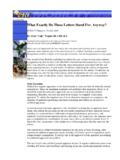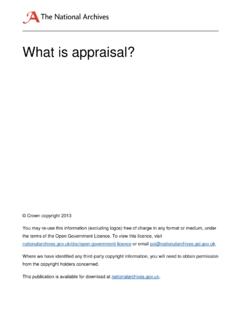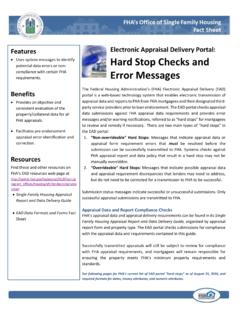Transcription of How the Relocation Appraisal Differs from Other …
1 How the Relocation Appraisal Differs from Other Appraisals MOBILITY Magazine, April 2001 By Alvin "Chip" Wagner III, SCRP, SRA, IFA Reprinted with permission of the Employee Relocation Council from the April 2001 issue of MOBILITY magazine. Wagner describes the essential differences between a Relocation Appraisal and a mortgage Appraisal in areas such as reporting format, intended use, value definition, and comparables, among others. The article is intended for the Relocation professional and the transferee. "I just had an Appraisal done a couple of months ago when I refinanced my home. Why do I need to have another done now that I am being transferred?" Most real estate professionals who specialize in the Relocation industry probably have heard a question similar to this from a transferee. Although the answer is very important, it is not always an easy one for the non-appraiser to answer.
2 The Relocation Appraisal is an essential component of the Relocation process, and transferees need to understand the differences in the types of appraisals. A professional real estate appraiser is a specialist who follows the same set of steps on every Appraisal assignment. This is called the Appraisal process. Every Appraisal requires the same organized collection and analysis of data. After the research is complete, the appraiser must choose a format for presenting the report. The appraiser can select a narrative-style report or a form -style report, depending on the type of property and the intended use and purpose of the Appraisal . The most common reason for a real estate Appraisal of a residential dwelling is mortgage loan underwriting (both purchase and refinancing). A standardized form report called the Uniform Residential Appraisal Report (URAR) is the most common form , although various new abbreviated forms have been introduced and have become popular in the residential loan underwriting market in recent years.
3 Appraisers may use the URAR for Other purposes including, but not limited to, private mortgage insurance (PMI) removal, estate/trust valuation, divorce, estimated market value for buyers or sellers, insurance, tax appeal, and foreclosure appraisals. The 2001 Employee Relocation Council Summary Appraisal Report is now in its fifth revision since its development and industry standardization in 1984. It is a form -style report that requires substantial narrative components and addenda to adequately address the clients' concerns and needs. It is different from all Other types of form Appraisal reports. To the non-appraiser, some of these differences are very subtle and others are very obvious but not completely understood. The "Difference Between Mortgage Versus Relocation Appraisals" outline (See Figure 1.) was originally developed by ERC and ERC Appraisal Standards Council members and has been used in many seminars, courses, and training materials for years.
4 It has been updated for this article to reflect both the changes in the 2001 ERC Summary Appraisal Report and the latest Uniform Standards of Professional Appraisal Practice. The Relocation Appraisal has a specific set of definitions and guidelines for appraisers. These guidelines for the Relocation Appraisal differ substantially from Other types of appraisals. This article will directly follow and address the updated outline. Reporting format. The mortgage Appraisal uses the URAR, a two-page form that is a comprehensive analysis of the subject property's site and physical characteristics (New abbreviated reporting formats approved by the lending industry allow for even shorter forms and drive-by opinions.). The Relocation Appraisal is completed on the ERC Summary Appraisal Report, a six-page report, which employs techniques similar to those used for the mortgage Appraisal . However, the appraiser must provide a much higher degree of analysis in the narrative portions to complete the form .
5 Intended use. The mortgage Appraisal 's intended use is to assist the lender in evaluating a property for purposes of mortgage/bank loan underwriting. The intended user of a mortgage Appraisal is the client, generally a bank or mortgage company. The intended use of the Relocation Appraisal is to help an employer facilitate the employee Relocation process. The intended users of the Relocation Appraisal are the appraiser's client ( Relocation management company) and the employer. Although the report often is shared with the transferee, he or she is not an intended user. Purpose. The mortgage Appraisal is used to develop an opinion of the market value of a property. The Relocation Appraisal is used to develop an opinion of the anticipated sales price of a relocating employee's residence. Value definitions. The two Appraisal formats use different value definitions: The mortgage Appraisal 's definition is called "market value" and the Relocation Appraisal 's definition is called "anticipated sales price.
6 " According to the Uniform Residential Appraisal Report/Freddie Mac form 439/Fannie Mae form 1004B, the definition of market value is: The most probable price which a property should bring in a competitive and open market under all conditions requisite to a fair sale, the buyer and seller, each acting prudently, knowledgeable and assuming the price is not affected by undue stimulus. Implicit in this definition is the consummation of a sale of a specified date and the passing of title from seller to buyer under conditions whereby: buyer and seller are typically motivated; both parties are well-informed or well-advised, and each acting in what he considers his own best interest; a reasonable time is allowed for exposure to the open market; payment is made in terms of cash in dollars or in terms of financial arrangements comparable thereto; and the price represents the normal consideration for the property sold unaffected by special or creative financing or sales concessions granted by anyone associated with the sale.
7 According to the ERC Summary Appraisal Report/ERC Rev. 01/01, the definition of anticipated sales price is: The price at which a property is anticipated to sell in a competitive and open market, assuming an arms-length transaction whereby: the analysis reflects the subject property "as is" and is based on its present use as a residential dwelling; both buyer and seller are typically motivated: both parties are well-informed or well-advised and acting in what they consider their best interests; payment is made in cash or its equivalent; a reasonable marketing period, not to exceed 120 days and commencing on the date of Appraisal (inspection), is allowed for exposure in the open market. The analysis assumes an adequate effort to market the subject property; and forecasting is applied to reflect the anticipated trend of market conditions and prices during the subject property's prospective marketing period.
8 The primary differences in these two definitions are the marketing period, financing considerations, and the type of analysis (forecasting). Marketing period. The mortgage Appraisal 's definition of market value states a "reasonable time is allowed for exposure in the open market." This opinion of value is without limit. For example, the property's marketing time could be under 30 days, or it could be over two years, of which the latter would not affect the property's final opinion of market value. The Relocation Appraisal 's definition of anticipated sales price requires the appraiser to consider a "'reasonable' marketing period, not to exceed 120 days and commencing on the date of Appraisal (inspection), is allowed for exposure in the open market. The analysis assumes an adequate effort to market the subject property." This means if a property's neighborhood or marketplace has typical marketing periods exceeding 120 days, the subject will need to be discounted through the forecasting adjustment.
9 Financing considerations. The mortgage Appraisal requires cash equivalency with adjustments to the comparables if there are special or creative financing or sales concessions, but not for costs, which are normally paid by sellers as a result of tradition or law in a market area. The Relocation Appraisal requires the appraiser to reflect a cash equivalency price with adjustments to the sales prices of the comparables. Dollar adjustments should be made for concessions such as: seller-paid points, buyer's closing costs, interest rate buy downs, seller financing, or any Other terms that influence the final sale price. These adjustments are not necessarily dollar for dollar and should reflect the effect on the sales price resulting from the concession. Type of analysis. The mortgage Appraisal considers a retrospective analysis, looking at historical data as of the date of sale (or inspection if the property did not sell) without employing forecasting.
10 The Relocation Appraisal considers a prospective analysis, which employs a forecasting adjustment. According to the ERC Summary Appraisal Report, the definition of forecasting is: .."the process of analyzing historical trends and current factors as a basis for anticipating market trends. A forecasting adjustment is then applied to reflect any impact these trends will have on the subject property's marketing time and sales price." To arrive at a forecasting adjustment, the Relocation Appraisal provides extensive room for the appraiser to include narrative data on supply and demand and overall market conditions. Furthermore, the appraiser studies Other factors such as absorption rates; current inventory levels in the region, immediate area, or price range; and current compet it ion from new construction. Decision making. The mortgage Appraisal uses a long-term decision-making analysis for the life of the mortgage loan, sometimes up to 30 years.







